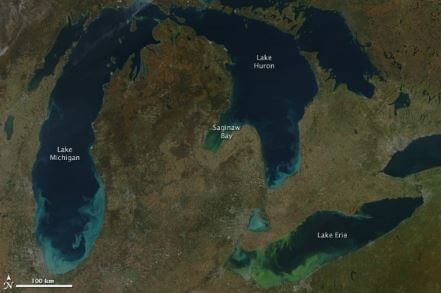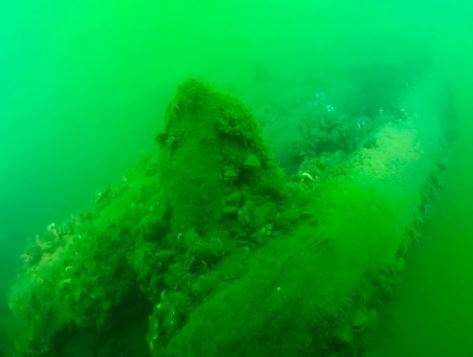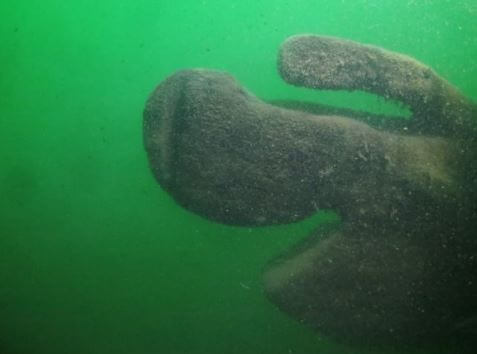
The mystery of the "Snake Wreck" from 1829 has definitely been solved
 17. 12. 2020
17. 12. 2020

After a long search, perhaps the oldest shipwreck in the Great Lakes of America was found. Everyone knows that sailors risked their lives on long voyages across oceans, but it is not just the oceans that pose a danger. Boats on the Great Lakes also faced a great danger of the water element, and at the bottom of the lakes there are plenty of shipwrecks to confirm this.
One of these shipwrecks is Lake Serpent. It was about a 47-foot-long schooner that sailed in 1829 from Cleveland to the Lake Erie Islands for a load of limestone. The ship arrived at the port, where it loaded the cargo and set out on the return journey, but never reached its destination. The bodies of the captain and his brother were washed ashore by the water west of Cleveland. According to Smithsonian.com, exactly what happened to Lake Serpent and where the ship sank remained unclear until recently.

Great lakes from above. Image courtesy of NASA with Jeff Schmaltz, MODIS Rapid response team at NASA GSFC
The wreck was located
The National Museum of the Great Lakes in Toledo has published a statement that the wreck of the "Snake", which is considered to be the oldest wreck of the Great Lakes, may have been located. His discovery is thanks to museum director Chris Gilchrist and a team of divers and archaeologists specializing in underwater work. The team searches and then investigates the wrecks found and uses the knowledge to refine their knowledge of historic transportation and travel in the region and, more broadly, throughout the United States. The lakes were the main transport route between the eastern states and the Midwest.
When Gilchrist began in what was then called the Inland Seas Maritime Museum, he noticed that it contained many artifacts from shipwrecks, but no real effort had ever been made to present them to the public. He noted that the museum's board of directors was full of shipping company executives who did not want people to think too much about the idea of sunken ships.
Finding more wrecks
He eventually changed their mind and convinced them that traveling on the lakes, including the unpleasant reality of sunken wrecks, was an integral part of history and should be treated accordingly. His opinion was supported by the public interest in similar things, which was based, among other things, on the popularity of the film Titanic.

This photo, provided by Cleveland Underwater Explorers Inc., shows the remains of a wreck found in the waters of Lake Erie, Ohio. (David M VanZandt / Cleveland Underwater Explorers Inc. via AP)
After a few years, the museum hired Carrie Sowden to become director of the archeology department, and also began working with a diving association that explores Lake Erie. Since the partnership began, the team has found about 12 wrecks in Lake Erie and several others in Lake Ontario. Each of these wrecks tells something of the history of its time. The Cleveland Underwater Explorers (CLUE) diving team has a number of engineers among its members. These engineers help the group streamline its research, select search targets, and find out where they are most likely hiding below the surface of lakes. Ideally, they search areas with a radius of 25 miles, which is still a very challenging task when you realize that searching one square mile with side-scan sonar takes about an hour.
This method was used by team members even when they came across something small off the coast of Kelley's Island, which is the current name of the island from which Lake Serpent once sailed before its disappearance. It was in 2015, but the signal seemed too weak to capture the shipwreck, so they left the object unnoticed.
Lake Serpent
Only a dive carried out in the same place a year later proved the wreck of a ship, part of which was buried at the bottom of the lake under a layer of sediment. The boat was wooden and small, which indicated to the team that it was probably very old. They originally thought they were the remains of another ship, the Lexington, which sank in the 40s. After several more exploratory dives and research on land, they finally concluded that it was probably Lake Serpent. They were led to find records that Lake Serpent had a carved snake on the bow, which corresponded to the wreck found.
According to other records, Lake Serpent was carrying a cargo of stone at the time of the shipwreck, and diving teams did find large boulders in the ship's hold. The belief that the vessel found was indeed Lake Serpent was also supported by the fact that the stones were very roughly broken. If the stone were mined later, it would be better worked.
According to Sowden, it is currently possible to determine with about 75% certainty that the vessel they found is missing Lake Serpent. Further research will be needed before this can be confirmed with 100% certainty. The vessel is just one of several wrecks the team found this year.
Risk of shipwreck
The weather in the Great Lakes can be quite dangerous, so there is a higher probability of shipwrecks, and the Great Lakes have a higher wreck density per square mile than any other body of water. At the bottom of Lake Erie alone lie about 2 wrecks. This lake is shallower than the rest of the Great Lakes, which makes finding wrecks easier. On the other hand, this means that the ships found are usually in a worse condition than those that are deeper.
Due to Ohio law, the museum will not be able to exhibit anything the divers find in the wreckage if the shipwreck turns out to be Lake Serpent. Instead, he will at least give a series of lectures at the various regional institutions that helped fund the project.
Tip from the Sueneé Universe e-shop - with personal collection, you can be sure of a gift under the tree! ;-)
Colin Campbell: A New Chinese Study
The most valuable thing you can donate is health. Or at least inspiration, how to strengthen your immunity thanks to diet and thus prevent diseases during these difficult times. Bestseller devoted to the Chinese study of the connection between diet and disease. Her conclusions are surprising. It's a story that needs to be heard. Bestseller in the USA. We recommend!
Michaela Hearing: My Moon - the path of self-knowledge
Are you looking for a way to calm down and harmonize inside? And you don't know exactly how to do it? Let yourself be guided…
The Key to Self-Development - A unique interactive publication, containing a set of 32 task cards, a creative diary and a recording of high-vibration meditation music. You will not regret!





 1
1


